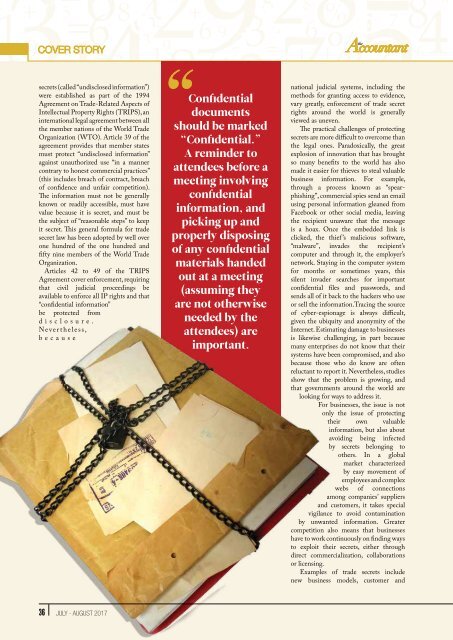The-Accountant-Jul-Aug-2017
Create successful ePaper yourself
Turn your PDF publications into a flip-book with our unique Google optimized e-Paper software.
COVER STORY<br />
secrets (called “undisclosed information”)<br />
were established as part of the 1994<br />
Agreement on Trade-Related Aspects of<br />
Intellectual Property Rights (TRIPS), an<br />
international legal agreement between all<br />
the member nations of the World Trade<br />
Organization (WTO). Article 39 of the<br />
agreement provides that member states<br />
must protect “undisclosed information”<br />
against unauthorized use “in a manner<br />
contrary to honest commercial practices”<br />
(this includes breach of contract, breach<br />
of confidence and unfair competition).<br />
<strong>The</strong> information must not be generally<br />
known or readily accessible, must have<br />
value because it is secret, and must be<br />
the subject of “reasonable steps” to keep<br />
it secret. This general formula for trade<br />
secret law has been adopted by well over<br />
one hundred of the one hundred and<br />
fifty nine members of the World Trade<br />
Organization.<br />
Articles 42 to 49 of the TRIPS<br />
Agreement cover enforcement, requiring<br />
that civil judicial proceedings be<br />
available to enforce all IP rights and that<br />
“confidential information”<br />
be protected from<br />
disclosure.<br />
Nevertheless,<br />
because<br />
Confidential<br />
documents<br />
should be marked<br />
“Confidential.”<br />
A reminder to<br />
attendees before a<br />
meeting involving<br />
confidential<br />
information, and<br />
picking up and<br />
properly disposing<br />
of any confidential<br />
materials handed<br />
out at a meeting<br />
(assuming they<br />
are not otherwise<br />
needed by the<br />
attendees) are<br />
important.<br />
national judicial systems, including the<br />
methods for granting access to evidence,<br />
vary greatly, enforcement of trade secret<br />
rights around the world is generally<br />
viewed as uneven.<br />
<strong>The</strong> practical challenges of protecting<br />
secrets are more difficult to overcome than<br />
the legal ones. Paradoxically, the great<br />
explosion of innovation that has brought<br />
so many benefits to the world has also<br />
made it easier for thieves to steal valuable<br />
business information. For example,<br />
through a process known as “spearphishing”,<br />
commercial spies send an email<br />
using personal information gleaned from<br />
Facebook or other social media, leaving<br />
the recipient unaware that the message<br />
is a hoax. Once the embedded link is<br />
clicked, the thief ’s malicious software,<br />
“malware”, invades the recipient’s<br />
computer and through it, the employer’s<br />
network. Staying in the computer system<br />
for months or sometimes years, this<br />
silent invader searches for important<br />
confidential files and passwords, and<br />
sends all of it back to the hackers who use<br />
or sell the information.Tracing the source<br />
of cyber-espionage is always difficult,<br />
given the ubiquity and anonymity of the<br />
Internet. Estimating damage to businesses<br />
is likewise challenging, in part because<br />
many enterprises do not know that their<br />
systems have been compromised, and also<br />
because those who do know are often<br />
reluctant to report it. Nevertheless, studies<br />
show that the problem is growing, and<br />
that governments around the world are<br />
looking for ways to address it.<br />
For businesses, the issue is not<br />
only the issue of protecting<br />
their own valuable<br />
information, but also about<br />
avoiding being infected<br />
by secrets belonging to<br />
others. In a global<br />
market characterized<br />
by easy movement of<br />
employees and complex<br />
webs of connections<br />
among companies’ suppliers<br />
and customers, it takes special<br />
vigilance to avoid contamination<br />
by unwanted information. Greater<br />
competition also means that businesses<br />
have to work continuously on finding ways<br />
to exploit their secrets, either through<br />
direct commercialization, collaborations<br />
or licensing.<br />
Examples of trade secrets include<br />
new business models, customer and<br />
36 JULY - AUGUST <strong>2017</strong>

















